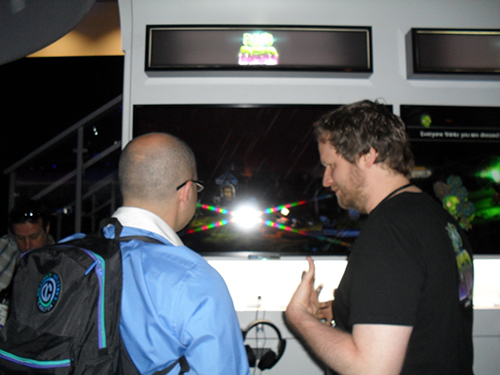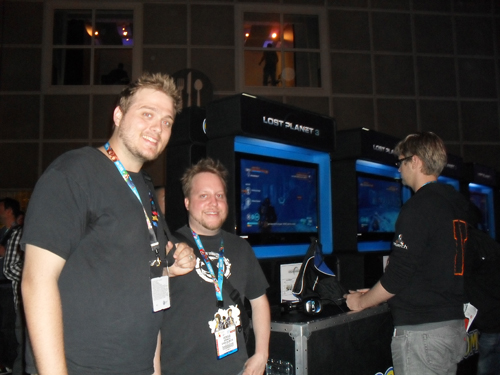Through new consoles and new games to run on them, E3 saw the introduction of a range of technologies and capabilities that left developers, engineers and other game professionals with greater insight into the skills they need to develop if they’re going to continue their success in the field. “The things that I saw at E3 that inspired me were a lot of new technologies that are multi-core or multi-thread,” said Shawn Halwes, a programmer at Ragtag Studio. In a
blog post late last year,
Microsoft noted that when it comes to creating games for multi-core systems, many new devices require multi-threaded code in order to take advantage of their additional horsepower. That makes development more complicated, since the multi-threaded approach can create new design and programming challenges. [caption id="attachment_94727" align="aligncenter" width="500"]
 A player tests out “Ray’s Dead,” while Ragtag Studio programmer
A player tests out “Ray’s Dead,” while Ragtag Studio programmer
Shawn Halwes offer advice
[/caption] A veteran programmer with a specialty in graphics, Halwes says one key area he plans to focus on is the use of artificial intelligence. For Ragtag’s
Ray’s the Dead, he says: “I need to provide a tool set for artificial intelligence to the designers. If I want to have [the game’s] minions follow you in a group, I need some level of artificial intelligence. The next big area in games will be artificial intelligence.” Microsoft included a taste of AI in its
Forza Motorsport 5 racing game for the Xbox One. Through the cloud, the company is aiming to use AI with its “drivatars,” which is the game’s way of referring to avatars. Basically, the game will learn about how you drive and apply those characteristics to your gameplay. Cloud and social media skills are also areas Halwes is keeping an eye on. [caption id="attachment_94728" align="aligncenter" width="500"]
 E3 attendees line up to enter one of the demo halls,
E3 attendees line up to enter one of the demo halls,
where Microsoft’s presence loomed large.
[/caption] Other developers came away convinced there were different areas to emphasize. For example, some pointed to an increasing need to be flexible in their development approach so games can run on multiple devices – in other words, cross-platform. “You need to develop a game that can run on all PlayStation devices,” says Derek Hernandez, a producer for Bento Box Interactive. Microsoft got out in front of this road with the unveiling of its Project Spark, a tool kit that allows users to create their own games and share them with other players. The results can run on the Xbox as well as Microsoft’s Surface tablet. [caption id="attachment_94729" align="aligncenter" width="443"]
 E3 participants crowd the demo area of Sony’s PlayStation Indie developers.
E3 participants crowd the demo area of Sony’s PlayStation Indie developers.
[/caption] Christopher Donley, an associate producer with Spark Unlimited, which developed
Lost Planet 3, says he’s interested in understanding what
can’t be done with the new technologies. “I’m interested in finding tools to do something new and interesting,” he explained. “There was nothing groundbreaking here, where I felt out of the loop and needing to catch up my skills.” [caption id="attachment_94730" align="aligncenter" width="500"]
 L-R: Christopher Donley, associate producer for Spark Unlimited, and Nicholas Springer, senior QA tester for Spark Unlimited.
L-R: Christopher Donley, associate producer for Spark Unlimited, and Nicholas Springer, senior QA tester for Spark Unlimited.
[/caption]







